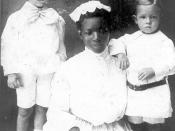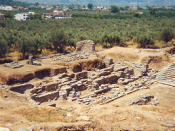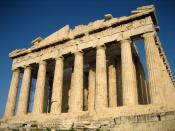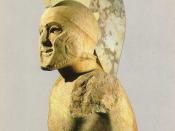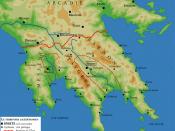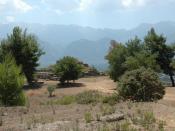1 Spartan Women The book Spartan Women, written by Sarah B. Pomeroy, is a detailed monograph explaining various areas of the life of women during the Greek era. Because this book is a monograph there is no story line or character to follow throughout the book. There is simply a statement of facts separated by different topics. The characters discussed in Spartan Women are historical figures such as heroin and goddesses that have played a major role in Greek civilization. The main focus is directed to the women of Sparta. Throughout the book Pomeroy compares the lives of Spartan women to that of the Athenian women, another well known Greek state.
There are six areas of life that Sarah Pomeroy discusses. This includes education, becoming a wife, the creation of mothers, elite women, the lower classes, and women and religion. The two areas that will be reviewed are education and women and religion.
The topic of education discusses the different areas of education ranging from reading and writing to the 2 physical fitness of women. The diversity of Spartan and Athens is also compared in this section.
In ancient times the education that a child received was the sole responsibility of their parents. In Athens the boys were to some degree encouraged by the public to be educated. Girls on the other hand were kept hidden from the public and were taught at home by the women of the household. They were taught the skills that would be needed once they were adults such as nurturing and cooking. Sparta was the only state that had set up an educational program for both young boys and girls. The boys' educational program was by far much harder than the girls'. The boys, from a young age, were trained to become soldiers whom Sparta depended on in order to hold the states power. The girls on the other hand were educated in becoming mothers in order to generate the best Spartan men and women possible. As for literacy it was not very important for any class other than the elite. There was however, no large majority between the number of men and women that could read as compared to that of other states such as Athens.
The physical education, or athletics, of Spartan women are the best known area of their life due to the large amount of evidence found on the subject. The involvement of 3 Spartan women in athletics was more than likely unique in Greece because of the attraction of writers to the activities. The physical training of both the men and the women included activities such as running, wrestling, discus throwing, and hurling the javelin. The skills gained from these activities were very helpful in the training of soldiers. The program of both the men and the women was very much alike. The only difference was that the women's version was a little easier compared to the men's. it has always been questioned whether or not the men and women had competed against each other because their activities were so closely related. The only problem with this idea is the fact that competitions of strength would not be an efficient measure of training due to the differences in strength and speed of men compared to women.
The topic of women and religion explains the different ways in which Spartan women take part in the worship and celebration of goddesses and heroin in Greece. Pomeroy describes the cults and festivals that women participated in for the different gods and goddesses.
Everyone in ancient Greece worshiped the same gods and goddesses, but not always in the same ways. For example Athenian women worshiped by mourning the dead and forming 4 domestic cults. Spartans worshiped by public sphere. Their cults were public and reflected female beauty, health, and fertility. When celebrating goddesses and female heroes women were often involved in religious athletic events such as racing. One race that honors Hera was a premarital ritual. This race was a cult activity and was only held for parthenoi. They also had great banquets in which everyone drank wine and ate cake. In many celebrations women also sang and danced, and in some instances men also joined in the chorus.
In the first topic of the book, education, Sarah B. Pomeroy tries to explain the major differences between Spartan women and Athenian women. She also explains the similarities and differences in the educational programs of Spartan men and women.
Pomeroy proves her argument about the differences between Spartan women and Athenian women very well. She justifies the right of women in Sparta to be educated and to be able to compete in athletic activities such as racing, wrestling, discus throwing, and the hurling of javelins. Spartan women were also permitted to ride horses and chariots, something that Athenian women were never permitted to do. In contrast Athenian women were confined 5 to their homes to be shielded form the public. The only education that they received was the teachings of their mother and the other women in the house. The extent of this education only went as far as to teach the girls how to be good mothers and wives.
Sarah Pomeroy also proves her argument of the differences and similarities of the Spartan men and women's educational program. She explains that women followed almost the same curriculum as the men. The only difference was that the women's program was a little easier than the men's. Since the two programs are so closely related Pomeroy brings out the question of whether or not men and women participated in co-ed activities. The only problem with this theory that she discusses is the fact that due to the greater strength and speed of men the competitions of strength would be inefficient in their education.
In the topic of women and religion Sarah Pomeroy discusses the women's roles and how they differ in Sparta and Athens. She discusses the differences in cultic worship and the festive activities that they were able to participate in. women of Athens were involved in private cults and the activities in which they were permitted to take part in were activities such as weaving. The women of 6 Sparta were involved in public cults and celebrated by taking part in ritualistic activities such as racing, singing and dancing, and parades.
The detailed descriptions that Pomeroy gives throughout the book give a good understanding of the Greek time period and the years in which certain people lived. The subject of world civilization is also discussed fairly well because the author ties in other states by comparing them to Sparta.
This book gives a good under standing of the Greek time period because the author gives dates in which certain occurrences took place. She also give an understanding of the time period by tying in states that that were only in the Greek age during certain times and that are very familiar such as the Romans and the Messenians. Sarah Pomeroy writes about many historical figures such as Plato and many other scholars and poets of this time period.
World civilization is also discussed fairly well because Pomeroy gave insight to other Greek states by comparing them to Sparta. One state that Pomeroy focuses on extensively is the Athenians. She goes in detail discussing the differences between Athens and Sparta throughout the book. States that have affected Sparta are 7 also slightly discussed such as the Thebans who invaded Sparta in the year369 B.C.E.
The author of Spartan Women, Sarah B. Pomeroy, is a professor at Hunter College in New York. Over the last 27years she has written eleven articles and books. Some of Sarah Pomeroy's other publications include Goddesses, Whores, Wives, And Slaves, Women in Hellenistic Egypt from Alexander to Cleopatra, and Women in the Classical World.
Goddesses, Whores, Wives, and Slaves: Women in Classical Antiquity, published in 1975, was Pomeroy's first published book. This book gave her recognition as the leading authority pertaining to the conditions of life for ancient Greek and Roman women. She has held onto this title for over twenty five years. In 1984 Sarah Pomeroy published her, Women in Hellenistic Egypt from Alexander to Cleopatra, which also received great praise. Pomeroy later took a significant part in the creation of Women in the Classical World, a multiauthored volume in 1991(Skinner, par. 1).
The people that would benefit the most from this book would have to be history majors. In Spartan Women Sarah Pomeroy uses jargon and slang terminology that someone in a history major may pick up on and understand better than any 8 other college student or high school student would. This book would also help any general student taking a history course pertaining to the Greek age because it gives a good understanding of the time period of the Greek age by comparing the different states in which the student me be familiar with.
